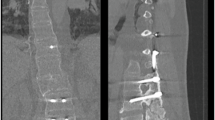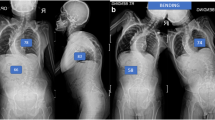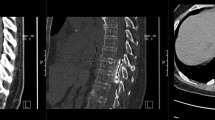Abstract
Study design
Analysis of published cases
Objectives
To identify and describe symptoms, radiologic findings, treatment strategies, and reoccurrence of Charcot spine in individuals with spinal cord injury (SCI).
Methods
This analysis included all English articles published prior to October 2017, describing Charcot spine after SCI as identified by multiple reviewers. Articles were excluded if Charcot spine was attributed to alternative conditions. Individual level data were available for 94% of reported cases. Outcomes included demographic factors, injury characteristics, clinical presentation, radiologic findings, management, and reoccurrence.
Results
Fifty included papers described 201 individuals with SCI who developed Charcot spine. 86% of individuals had paraplegia and 93% of individuals had a neurologically complete injury. Mean length of initial spinal fusion spanned 7.7 vertebral bodies (SD = 3.9). The most common presenting symptoms were back pain (56%), spinal deformity (48%), and crepitus (34%). Vertebral body destruction (83%), osteophytes (61%), and endplate destruction (57%) were commonly reported on radiographs. Reoccurrence of Charcot spine was described in 19% of cases after initial treatment.
Conclusion
Charcot spine after SCI commonly presents with low back pain and radiologic evidence of vertebral body destruction. Cases have been described more often in individuals with paraplegia and neurologically complete injuries. Surgical management is often pursued. A high rate of reoccurrence of Charcot spine in individuals with SCI after initial treatment has been reported.
Similar content being viewed by others
Log in or create a free account to read this content
Gain free access to this article, as well as selected content from this journal and more on nature.com
or
References
Johnson JTH. Neuropatbic fractures and joint injuries: pathogenesis and rationale of prevention and treatment. J Bone Joint Surg. 1967;49-A:l–30.
Standaert CJ, Cardenas DD, Anderson PA. Charcot spine as a late complication of traumatic spinal cord injury. Arch Phys Med Rehabil. 1997;78:221–5.
Zyck S, Toshkezi G, Pizzuti J, Marawar S. Four-rod instrumentation for treatment of charcot spinal arthropathy causing autonomic dysreflexia: case report and literature review. Cureus. 2016;8:e850.
Vaccaro AR, Silber JS. Post-traumatic spinal deformity. Spine. 2001;26(24S):S111–8.
Aebli N, Pötzel T, Krebs J. Characteristics and surgical management of neuropathic (Charcot) spinal arthropathy after spinal cord injury. Spine J. 2013;14:884–91.
Krebs J, Grasmück D, Pötzel T, Pannek J. Charcot arthropathy of the spine in spinal cord injured individuals with sacral deafferentation and anterior root stimulator implantation. Nuerourol Urodyn. 2014;35:241–5.
Barrey C, Massourides H, Cotton F, Perrin G, Rode G. Charcot spine: two new case reports and a systematic review of 109 clinical cases from the literature. Ann Phys Rehabil Med. 2010;53:200–20.
Kirshblum S, Waring W. Updates for the international standards for neurological classification of spinal cord injury. Phys Med Rehabil Clin N Am. 2014;25:505–17.
Aydinli U, Mohan N, Kara K. Post-traumatic charcot (neuropathic) spinal arthropathy at cervicothoracic junction: case report. World Neurosurg. 2016;94:580e1–4.
Garstang SV, Miller-Smith SA. Autonomic nervous system dysfunction after spinal cord injury. Phys Med Rehabil Clin N Am. 2007;18:275–96.
Dudley-Javoroski S, Shields RK. Muscle and bone plasticity after spinal cord injury: Review of adaptations to disuse and to electrical stimulation. J Rehabil Res Dev. 2008;45:283–96.
Turner JA, Cardenas DD, Warms CA, McClellan CB. Chronic pain associated with spinal cord injuries: a community survey. Arch Phys Med Rehabil. 2001;82:501–8.
Thumbikat P, Ravichandran G, McClelland MR. Neuropathic lumbar spondylolisthesis – a rare trigger for posture induced autonomic dysreflexia. Spinal Cord. 2001;39:564–7.
Morita M, Iwasaki M, Okuda S, Oda T, Miyauchi A. Autonomic dysreflexia associated with Charcot spine following spinal cord injury: a case report and literature review. Eur Spine J. 2010;19(sup2):S179–82.
Linsenmeyer TA, Campagnolo DI, Chou IH. Silent autonomic dysreflexia during voiding in men with spinal cord injuries. J Urol. 1996;155:519–22.
Denis F. The three column spine and its significance in the classification of acute thoracolumbar spinal injuries. Spine. 1983;8:817–31.
Jones EA, Manaster BJ, May DA, Disler DG. Neuropathic osteoarthropathy: diagnostic dilemmas and differential diagnosis. Radiographics. 2000;20:S279–93.
Brown CW, Jones B, Donaldson DH, Akmakjian J, Brugman J. Neuropathic (Charcot) arthropathy of the spine after traumatic spinal paraplegia. Spine. 1992;17(6S):S103–8.
Haus BM, Hsu AR, Yim ES, Meter JJ, Rinsky LA. Long-term follow up of the surgical management of neuropathic arthropathy of the spine. Spine J. 2010;10:e6–16.
Kasten MD, Rao LA, Priest B. Long-term results of iliac wing fixation below extensive fusions in ambulatory adult patients with spinal disorders. J Spinal Disord Tech. 2010;23:e37–42.
Lyman GH, Kuderer NM. The strengths and limitations of meta-analyses based on aggregate data. BMC Med Res Methodol. 2005;5:14.
Acknowledgements
We would like to especially thank Dr. Jörg Krebs for his help in providing deidentified individual data from pertinent aggregate Charcot spine case series.
Author contributions
RS was responsible for designing the review protocol, data extraction and analysis, interpreting results, and manuscript preparation. JMD was responsible for designing the review protocol, data verification, interpreting results, and manuscript preparation. SCK was responsible for designing the review protocol, interpreting results, and manuscript preparation.
Author information
Authors and Affiliations
Corresponding author
Ethics declarations
Conflict of interest
The authors declare that they have no conflict of interest.
Electronic supplementary material
Rights and permissions
About this article
Cite this article
Solinsky, R., Donovan, J.M. & Kirshblum, S.C. Charcot Spine following chronic spinal cord injury: an analysis of 201 published cases. Spinal Cord 57, 85–90 (2019). https://doi.org/10.1038/s41393-018-0216-6
Received:
Revised:
Accepted:
Published:
Issue date:
DOI: https://doi.org/10.1038/s41393-018-0216-6
This article is cited by
-
Exceptional Spinal Mobility Caused by Charcot Disease: Case Description with Several Years of Follow-Up
Indian Journal of Orthopaedics (2023)
-
Resection of hip heterotrophic ossification leads to resolution of autonomic nervous system dysfunction in a patient with spinal Charcot arthropathy: a case report
Spinal Cord Series and Cases (2020)



